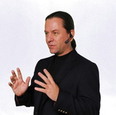In part one we talked about the body mechanics involved in breathing. In this article we will talk about a subtler energetic aspect of qigong breathing. This is the part of your practice that makes qigong different from other physical exercises. Mindfulness. There is a saying in Chinese, "Yo yi yo qi" translated it means, "Where the mind goes the qi goes." This is an extraordinarily important point later in practice. For now, suffice it to say that the mind directs the qi. There are countless ways and methods to put this into action. Lets look at some fundamentals as they apply to qigong practice.
Remember that qi and air are the same character in written Chinese. Air, even though it is a gas still has substance, as we know it. Air goes into the body through the nose and into the lungs where it is transformed. Oxygen is removed where it can be used in other body processes and the "used" or "impure" air is expelled in the form of carbon dioxide. Although qi has no substance, it does have function. It goes through a similar process. Qi is taken into the body where it is transformed into something useful to us. Also, impure qi is expelled. Since qi, unlike air, doesn't have substance it is not so restricted as to exactly how and where it can enter the body.
Just like your lungs hold air, your lower abdomen holds qi. This place in your lower abdomen is called the "Dan Tien" or the Elixer Field. One method in qigong breathing is to imagine that with each in breath qi comes in through the top of your head then descends to the lower abdomen where it is stored for further transformation and use. With each out breath any impure qi is exhaled through your mouth or your nose. This method may be used at the beginning of a practice session or throughout the entire session.
Another powerful breathing method is to imagine that you can breathe through each pore in your skin. As you breathe in, imagine that your pores open when the breath begins to come in and that air flows through your pores into your body. When you exhale, exactly the opposite happens. The breath flows out of the pores from your body. You may feel the sensation on your skin immediately or might choose to visualize the air moving in and out of your body through your skin.
Both of these methods can applied generally to qigong practices that do not otherwise specify a particular type of breathing. You can also use them in conjunction with the natural breathing technique we discussed in part one of this series.
Michael Roland, L.Ac., MTCM is now available for remote qigong sessions at www.MichaelRoland.com
Catch me on FaceBook!
Michael Roland received his Masters degree in Traditional Chinese Medicine in 1993. He worked in Dr. Andrew Weil's Program in Integrative Medicine at the University of Arizona, from 1997 to 2006, as clinician, preceptor, editor and consultant. Michael has written protocols for a studying the effects of Chinese medicine on heart transplant patients for the National Institutes of Health in the United States.
He has also taught clinical practices courses at the Arizona School for Acupuncture and Oriental Medicine. Under his appointment as Clinical Lecturer at the University of Arizona, College of Medicine, he has participated in multidisciplinary training sessions for third and fourth year medical students. Michael has studied under recognized masters in Beijing, PRC and Taiwan.
Michael now practices his disciplines in a remote healing format with clients from around the world. www.MichaelRoland.com

Post new comment
Please Register or Login to post new comment.